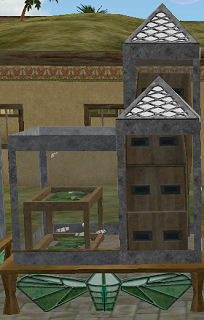The Wiki for Tale 7 is in read-only mode and is available for archival and reference purposes only. Please visit the current Tale 11 Wiki in the meantime.
If you have any issues with this Wiki, please post in #wiki-editing on Discord or contact Brad in-game.
Difference between revisions of "Silkworm Farm"
m (→Use) |
m |
||
| Line 1: | Line 1: | ||
{{Languages}} | {{Languages}} | ||
| − | |||
| − | |||
{{Template:BuildingInfo|image=Silkfarm.jpg|size=11x11|where=[[where::Compound]]|description=For raw silk production.}} | {{Template:BuildingInfo|image=Silkfarm.jpg|size=11x11|where=[[where::Compound]]|description=For raw silk production.}} | ||
== Source == | == Source == | ||
| − | This building becomes available when you learn the [[Silkworm Farming]] skill. It should be noted that unlike many other buildings, the [[Silkworm Farming]] skill is required to use it. | + | This building becomes available when you learn the [[requires::Silkworm Farming]] skill. It should be noted that unlike many other buildings, the [[Silkworm Farming]] skill is required to use it. |
== Cost == | == Cost == | ||
Revision as of 17:30, 13 April 2016
| English | Deutsch | français | magyar | Türkçe |

| |
|---|---|
| Size | 11x11 |
| Where | Compound |
Source
This building becomes available when you learn the Silkworm Farming skill. It should be noted that unlike many other buildings, the Silkworm Farming skill is required to use it.
Cost
- 200 Nontoxic Boards
- 25 Papyrus Paper
- 50 Iron
- 50 Sheet Glass
- 10 Copper Sheeting
- 1 Thermometer
- 20 turquoise Paint
- 20 pale turquoise Paint
Built in a Compound. Uses 11x11 cells.
Use
Silkworms generate Raw Silk when fed the proper Thistles, grown in a Thistle Garden. If they are not fed, they will still survive.
The Silkworms go in a 4-day cycle, starting from when you build the farm:
- 12 hours waiting for the next generation to be laid.
- 3 days eggs waiting to hatch. During this period the farm will display the current requirements.
- 12 hours either growing and eating (if fed), or simply surviving.
The type of thistle required will change after a cycle where the silkworms have been fed at least one thistle. If they are not fed, no silk will be produced and the thistle requirements will not change.
Output
The amount of Raw Silk returned after the silkworms are fed is based on the amount of Thistle they were given (in addition to a small random factor), but it is not a simple linear relationship.
- For small amounts of Thistle, the Raw Silk returned will follow an approximately 1:1 ratio.
- As more Thistle is added, the ratio will at first increase, peaking around 500-600 Thistle at about 1.5:1.
- After the peak, the ratio will begin to decrease, returning to 1:1 at around 1000 Thistle.
- After 1000 Thistle, the ratio continues to decline sharply, reducing the value of adding additional Thistle.
- 1000 Thistle produces 1200-1300 Raw Silk.
- Confirmed test that 4.6k thistles only gave back 1.4k of silk, a ratio of approx 1:0.3
Update 3/19/16
T7 Example:
690 Thistle -> 931 raw silk 1.35 yield per thistle
900 Thistle -> 907 raw silk 1.01 yield per thistle
1150 Thistle ->1043 raw silk .91 yield per thistle
1200 Thistle -> 1141 raw silk .95 yield per thistle
1200 Thistle -> 1156 raw silk .96 yield per thistle
In cases where volume is more important than efficiency, it may still be profitable to operate at a lower or less efficient ratio in exchange for the additional raw production.